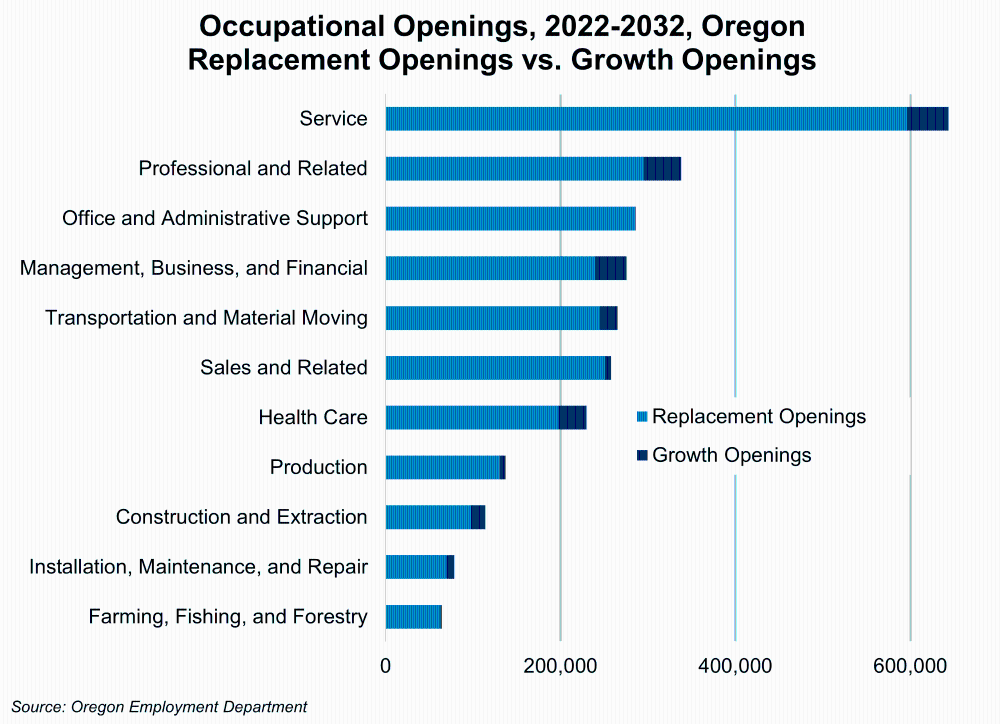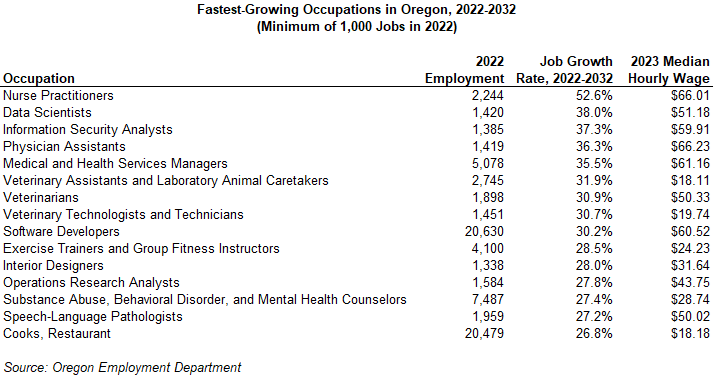10-Year Occupational Projections Show Broad-Based Job Opportunities Statewide
December 21, 2023Oregon’s total employment will grow 10% (221,600 jobs) between 2022 and 2032, according to new projections from the Oregon Employment Department. Employment gains primarily reflect structural growth in the economy, as employment in many sectors had largely recovered from pandemic losses by 2022. In addition to new jobs created over the decade, many job openings are expected due to the need to replace workers who leave their occupations.
Where Are the Job Openings Focused?
Among the broad occupational groups, health care (+16.8%) tops the list for fastest growing by 2032. The fast growth in health care occupations is attributed to the aging of Oregon’s population, longer life expectancies, and an expected rebound in Oregon’s long-term population growth. Service occupations, which include food preparation and serving workers, personal appearance workers, protective services, and building and grounds cleaning, rank first with the most job openings (643,600). The fast growth in service occupations is mainly caused by the job losses incurred in 2020. Service occupations require face-to-face interaction with consumers and many workers in this group lost their jobs during the Pandemic Recession. Service occupations made up 15% of jobs in 2022 and are projected to comprise 24% of the job openings over the decade.

Over this period most job openings are projected due to the need to replace workers leaving their occupations. Nine out of 10 job openings (2.5 million) are expected due to the need to replace workers who retire, leave the labor force for other reasons, or make a major occupational change, with the remaining openings due to new or expanding businesses. Replacements overshadow growth openings in all broad occupational categories.
Detailed Occupations
Occupations expected to have the most job openings include fast food workers, stockers and order fillers, retail salespersons, cashiers, home health and personal care aides, and waiters and waitresses.
In terms of fastest-growing, eight of the 15 fastest-growing occupations with 2022 employment of 1,000 or more are health care occupations and those associated with health care. They include nurse practitioners, physician assistants, medical health and services managers, mental health counselors, speech-language pathologists, veterinarians, veterinary assistants, and veterinary technicians.
Computer and mathematical occupations comprise four of the 15-fastest growing occupations. They include data scientists, information security analysts, software developers, and operations research analysts. Rapid growth in computer occupations is due to the increasing volume of data generated from businesses’ and consumers’ expanding digital presence, which increases demand for workers who can model, interpret, and analyze data.
Other top-growing occupations include those related to leisure and hospitality – exercise trainers and fitness instructions and restaurant cooks. The fast growth in projected employment for these occupations is driven by the job losses in the sector in 2020 and the sector’s continued recovery.
On the other end of the scale, employment levels among several occupations are expected to decline. That includes executive and legal secretaries, data entry keyers, bank tellers, telemarketers, executive secretaries and administrative assistants, new accounts clerks, bill and account collectors, and file clerks.
Education
In 2022, six out of 10 jobs in Oregon typically required a minimum of high school education or less. To meet more competitive requirements for Oregon's jobs, six out of 10 required education beyond high school.
Occupations with the most job openings typically requiring a high school diploma or less include fast food workers, stockers and order fillers, retail salespersons, and cashiers. Those requiring a postsecondary certification or associate’s degree include home health and personal care aides, office clerks, bookkeepers, and truck drivers. Occupations with the most job openings requiring at least a bachelor’s degree vary from general and operations managers to registered nurses, other educational instruction and library workers, farmers, ranchers, and other agricultural managers, and software developers.
Additional Information
The 2022-2032 employment projections for Oregon are produced for about 100 industries and 800 occupations. More information on industry and occupational projections for Oregon and sub-state areas can be found at QualityInfo.org/projections.